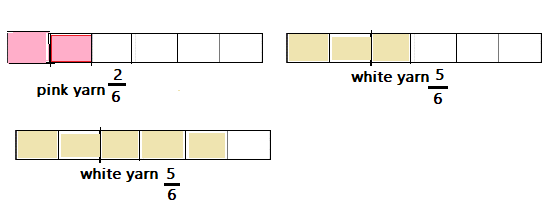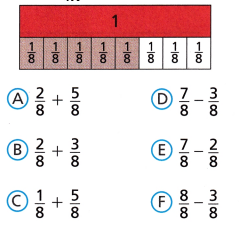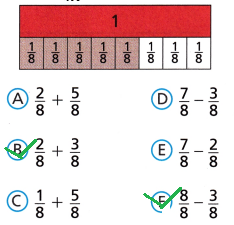We included HMH Into Math Grade 4 Answer Key PDF Module 14 Review to make students experts in learning maths.
HMH Into Math Grade 4 Module 14 Review Answer Key
Vocabulary
Choose the correct term from the Vocabulary box to complete the sentence.
Vocabulary
common denominator
common numerator
equivalent fraction
unit fraction
Question 1.
When two or more fractions have the same denominator, they have a ____________.
Answer:
Like fractions
Explanation:
When two or more fractions have the same denominator are called like fractions.
\(\frac{7}{10}\) + \(\frac{2}{10}\) = \(\frac{9}{10}\)
Question 2.
A ___________ has a numerator of 1.
Answer:
Unit fraction
Explanation:
A unit fraction is a rational number written as a fraction where the numerator is one and the denominator is a positive integer.
A unit fraction is therefore the reciprocal of a positive integer,
For example are 1/1, 1/2, 1/3, 1/4, 1/5, etc.
Concepts and Skills
Write the fraction as the sum of unit fractions.
Question 3.
\(\frac{2}{5}\) = ___________
Answer:
\(\frac{1}{5}\) + \(\frac{1}{5}\)
Explanation:
A fraction where the numerator is always one and denominator is an positive integer.
\(\frac{1}{5}\) + \(\frac{1}{5}\) = \(\frac{2}{5}\)
Question 4.
\(\frac{3}{10}\) = ___________
Answer:
\(\frac{1}{10}\) + \(\frac{1}{10}\) + \(\frac{1}{10}\)
Explanation:
A fraction where the numerator is always one and denominator is an positive integer.
\(\frac{1}{10}\) + \(\frac{1}{10}\) + \(\frac{1}{10}\) = \(\frac{3}{10}\)
Use Tools Write the fraction as a sum of fractions in two different ways. Tell what strategies or tools you will use to answer the questions, explain your choices, and the find the answers.
Question 5.
\(\frac{6}{8}\) = ___________
= ___________
Answer:
\(\frac{6}{8}\) = \(\frac{4}{8}\) + \(\frac{2}{8}\)
\(\frac{6}{8}\) = \(\frac{1}{8}\) + \(\frac{1}{8}\) + \(\frac{1}{8}\) + \(\frac{1}{8}\)
+ \(\frac{1}{8}\) + \(\frac{1}{8}\)
Explanation:
We can write the sum as unit fraction that always has 1 as its numerator,
it tells the part of each whole represents a unit fraction.
We can write a fraction as a sum by breaking a part of the numerator into addends and using the same denominators.
Question 6.
\(\frac{7}{10}\) = __________
= ___________
Answer:
\(\frac{7}{10}\) = \(\frac{4}{10}\) + \(\frac{3}{10}\)
\(\frac{7}{10}\) = \(\frac{1}{10}\) + \(\frac{1}{10}\) + \(\frac{1}{10}\) + \(\frac{1}{10}\)
+ \(\frac{1}{10}\) + \(\frac{1}{10}\) + \(\frac{1}{10}\)
Explanation:
We can write the sum as unit fraction that always has 1 as its numerator,
it tells the part of each whole represents a unit fraction.
We can write a fraction as a sum by breaking a part of the numerator into addends and using the same denominators.
Find the sum.
Question 7.
\(\frac{4}{12}\) + \(\frac{3}{12}\) = ___________
Answer:
\(\frac{7}{12}\)
Explanation:
We find the sum by adding the numerators and using their common denominators.
Question 8.
\(\frac{6}{10}\) + \(\frac{32}{100}\) = ____________
Answer:
\(\frac{92}{100}\)
Explanation:
Convert the tenths into hundredths by multiplying both numerator and denominator with 10.
\(\frac{6}{10}\) x \(\frac{10}{10}\) = \(\frac{60}{100}\)
We find the sum by adding the numerators and using their common denominators.
\(\frac{60}{100}\) + \(\frac{32}{100}\) = \(\frac{92}{100}\)
Question 9.
\(\frac{2}{8}\) + \(\frac{4}{8}\) + \(\frac{1}{8}\) = ___________
Answer:
\(\frac{7}{8}\)
Explanation:
We find the sum by adding the numerators and using their common denominators.
Question 10.
\(\frac{3}{10}\) + \(\frac{2}{10}\) + \(\frac{1}{10}\) = ___________
Answer:
\(\frac{6}{10}\)
Explanation:
We find the sum by adding the numerators and using their common denominators.
Find the difference. Select the correct answer.
Question 11.
\(\frac{7}{10}\) – \(\frac{2}{10}\)
(A) \(\frac{4}{10}\)
(B) \(\frac{5}{10}\)
(C) \(\frac{8}{10}\)
(D) \(\frac{9}{10}\)
Answer:
Option (B)
Explanation:
By subtraction the least fraction from the highest fraction we get the difference.
\(\frac{7}{10}\) – \(\frac{2}{10}\) = \(\frac{5}{10}\)
Question 12.
\(\frac{8}{12}\) – \(\frac{3}{12}\)
(A) \(\frac{5}{12}\)
(B) \(\frac{6}{12}\)
(C) \(\frac{9}{12}\)
(D) \(\frac{11}{12}\)
Answer:
Option (A)
Explanation:
By subtraction the least fraction from the highest fraction we get the difference.
\(\frac{8}{12}\) – \(\frac{3}{12}\) = \(\frac{5}{12}\)
Question 13.
Jen has \(\frac{2}{6}\) yard of pink yarn. She has \(\frac{3}{6}\) yard more white yarn than pink yarn. How much white yarn does Jen have? Describe a visual model you could use to justify your answer.
Answer:
\(\frac{5}{6}\) white yarn.

Explanation:
Jen has \(\frac{2}{6}\) yard of pink yarn.
She has \(\frac{3}{6}\) yard more white yarn than pink yarn.
\(\frac{2}{6}\) + \(\frac{3}{6}\) = \(\frac{5}{6}\)
Question 14.
Nico exercises for \(\frac{7}{12}\) hour. He spends some time running and \(\frac{4}{12}\) hour swimming. How long does he spend running?
Answer:
\(\frac{3}{12}\) hours
Explanation:
Nico exercises for \(\frac{7}{12}\) hour.
He spends \(\frac{4}{12}\) hour swimming.
Total hours he spend on running
\(\frac{7}{12}\) – \(\frac{4}{12}\) = \(\frac{3}{12}\)
Question 15.
Erica has \(\frac{6}{10}\) of a magazine left to read. After she reads some more of the magazine, she still has \(\frac{4}{10}\) left to read. What fraction of the magazine did Erica read?
Answer:
\(\frac{2}{10}\)
Explanation:
Erica has \(\frac{6}{10}\) of a magazine left to read.
After she reads some more of the magazine, she still has \(\frac{4}{10}\) left to read.
The fraction of the magazine Erica read = \(\frac{6}{10}\) – \(\frac{4}{10}\) = \(\frac{2}{10}\)
Question 16.
Select all the sums and differences that could be represented by this fraction model.

Answer:
Option B&F

Explanation:
When we add the given addends, we get the sum as
\(\frac{2}{8}\) + \(\frac{3}{8}\) = \(\frac{5}{8}\)
When we subtract the given fractions, we get the difference as
\(\frac{8}{8}\) – \(\frac{3}{8}\) = \(\frac{5}{8}\)